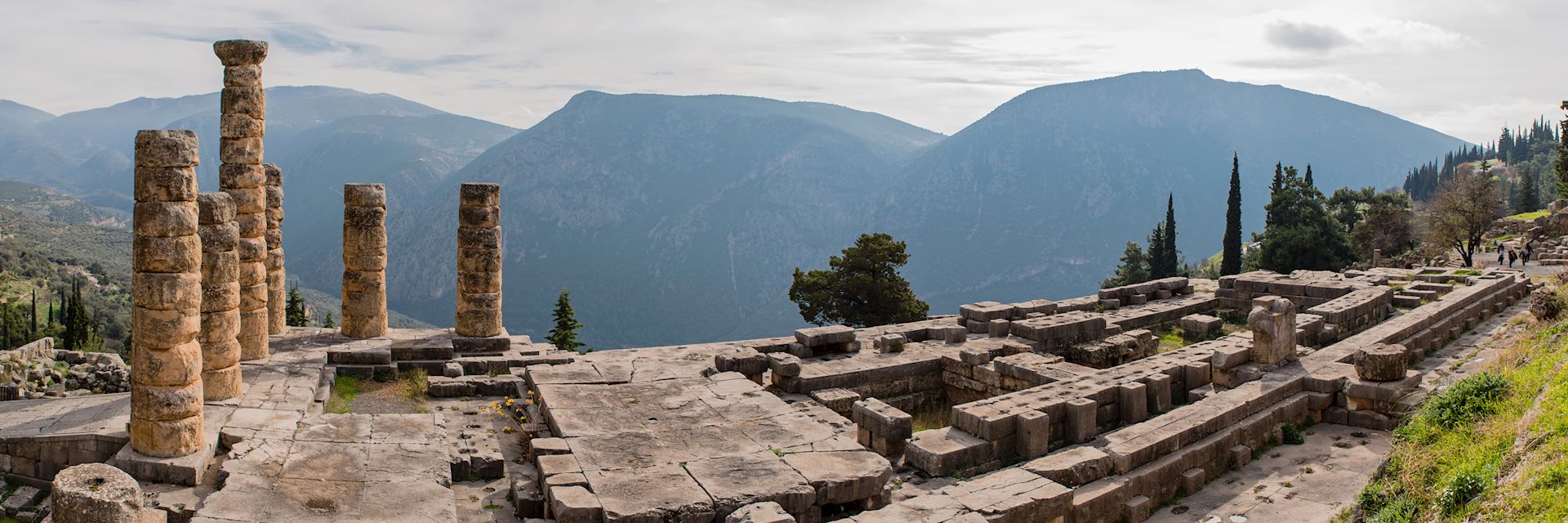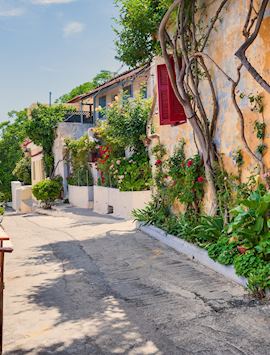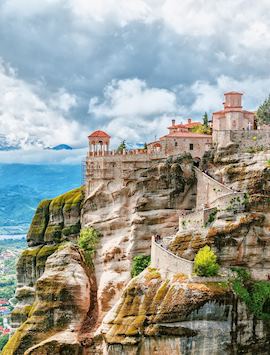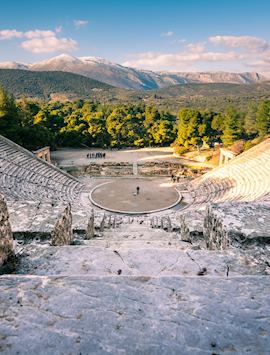By Greece specialist Abby
Land of myths and monsters, classical Greece is considered by many to be the cradle of European culture. Its ancient cities and monuments still hold a powerful draw for those, like me, who are fascinated by the way this long-gone culture still affects modern life.
In Greece, mythology and history weave together into a rich tapestry that’s more nuanced than the simplified myths I learned in school. That’s why I strongly suggest visiting with a private guide, who can help you get a more complete understanding of the long reach of Greek history. You can see all five sites on a 12-day tour of the highlights of Greece.
Pay homage to Athena at the Parthenon
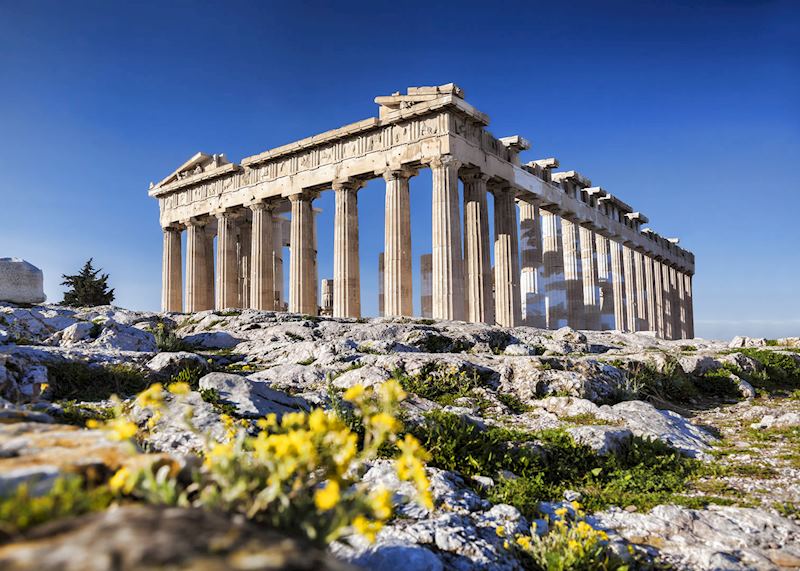
Looming high above Athens, the Parthenon’s elegant proportions and graceful columns have become a visual shorthand that practically defines ancient Greece. An enormous temple to the city’s patron goddess, it’s stood on the rocky outcrop (called the Acropolis) since 438 BC, as a symbol of the city’s power and prestige.
History hasn’t been kind to the temple, which was looted by the notorious Lord Elgin, desecrated by Christians who carved crosses into the stone, and, most devastatingly in 1687, accidentally blown up by Ottoman Turks, who used it as an ammunition depot. Nonetheless, it retains its majesty and visiting it is one of the first things I do whenever I visit Athens.
As with all ancient sites, a guide is imperative. My guide, Sandra, was a petite woman with a pixie cut and a penchant for flowing clothes. Though I’d visited the Acropolis several times, Sandra offered new insights as she explained the history and mythology that surrounds the site.
It’s thrilling to hear the story of Athena and Poseidon’s contest for Athens’ affection while standing next to the very olive tree that’s said to be planted by the goddess herself.
There are some logistical considerations. Cruise-ship crowds arrive mid-morning and depart mid-afternoon. To avoid them, and benefit from cooler temperatures, plan your trip for when the site opens at eight.
There’s no shade to speak of, aside from Athena’s olive tree, so a hat is vital. Also, be sure to wear comfortable walking shoes with good traction — the climb to the top of the Acropolis is long and a bit steep, and once you’re at the top the marble is so smooth it can be slick after it rains.
After your visit here, I strongly suggest going straight to the nearby Acropolis Museum, a recent and dazzling addition to Athens’ many museums. It showcases the temple’s remaining treasures and puts the history of the site in context.
Get advice from the Oracle at Delphi

Once the most important pilgrimage site in the classical world, Delphi was considered the hub of the universe by ancient Greeks. In the myth, Zeus released two eagles simultaneously from opposite ends of the Earth and they met here, on the slopes of Mount Parnassus. This is also where Apollo’s Oracle inhaled fumes from volcanic vents in the ground to commune with her god and offer cryptic answers to important questions.
Today it’s a popular destination, just over two hours from Athens. You can stay at the adjacent modern town that shares the site’s name, but I suggest basing your adventures in Galaxidi, a sleepy maritime town that’s a 35-minute drive away. Get an early start to avoid the worst of the heat and the crowds.
Sandra led me into the complex via the Sacred Way, a path that was once lined with statues and temples, but today is littered with broken columns and skeletal remains of long-gone buildings. She explained that there was more to Delphi than just the Oracle — this was the site of the Delphic or Pythian games, one of the four Pan-Hellenic competitions (the others are the Nemean, Isthmian and, of course, Olympic Games).
The ruins are impressive but compact and for most people, a few hours rambling through the stone blocks is probably enough. Be sure not to skip the small museum, where you can see the Omphalos. The name translates to ‘bellybutton’ — a nod to the fact that this was the navel of the world. The ancients believed this was the rock that Zeus’s mother gave to his father, Chronos, who swallowed it whole, thinking it was his son.
Take a ferry out to ancient Delos
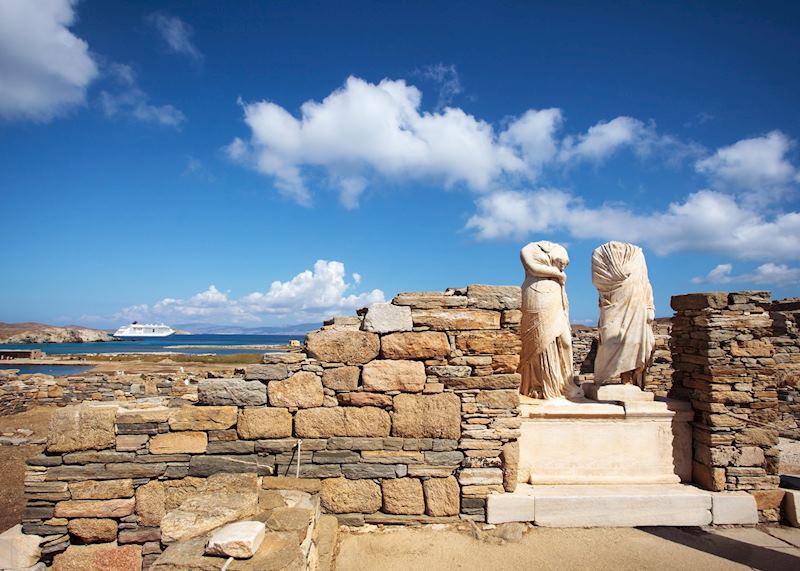
The Cycladic Islands draw their name from the Greek kyklos, for circle or cycle. The hub around which this cycle rotates is Delos, a sacred island that was the mythological birthplace of twin gods Apollo and Artemis. The city once rivalled Athens and Delphi for importance, though it went into steep decline after it was brutally ransacked twice in the first century BC.
Today, the island is slowly revealing its secrets to ongoing excavation. Archaeologists live in a small clutch of modern houses, but overnight stays are forbidden for everyone else, so you’re tied to the schedule of the ferry from nearby Mykonos.
There’s no shade to speak of on the island, just rugged land covered in marble ruins. My guide for the island, Marilena, suggested I visit in the late afternoon when the sun is less powerful. Wandering past anonymous foundations, she brought the cryptic remains to life, explaining which were once shops or temples, and pointing out the mosaics that mark the courtyards of now-fallen mansions.
The best-known feature on the island is the Terrace of Lions, a row of strange-looking creatures that might, if you squint a bit, look like lions. The ones that stand outside today are all replicas — most of the remaining originals are safely protected in the small Archaeological Museum on the island. (There’s also one in the Arsenale in Venice, looted from the island in the 1600s.)
The museum itself is small and somewhat cluttered, but worth a stop. In addition to the lions, you’ll also see mosaics, frescoes, other statues and everyday items that have been uncovered.
Go higher, faster, further at Olympia

Getting to Olympia can be something of a marathon because it’s located in the western mountains of the Peloponnese, a four-hour drive from Athens. But it’s wholly worth the effort, especially if you break up the journey mid-way with a wine-tasting lunch at a vineyard in Nemea.
This was the site of the original Olympic Games for more than 1,000 years, and where the torch of the modern Olympics is lit. However, the site originally functioned primarily as a holy place dedicated to Zeus. The temple here housed a statue of Zeus that was considered one of the Seven Wonders of the Ancient World, a towering artistic feat in marble, ivory and gold.
The statue is long gone, and all that remains of the temple is a handful of fluted columns collapsed into piles. But, looking at the remains, it was easy for me to imagine the imposing size and architectural magnificence of the original construction.
Archaeologists have left the site as they found it — sprawled across the ground, knocked down by an earthquake in the 6th century. Among the tumbled-down columns and shattered marble foundations, large trees offer a gracious amount of shade.
The one item that still seems untouched is the stadium where athletes competed. You can still stand on the starting blocks and race down the same track where the original Olympians ran.
The nearby modern town of Olympia serves primarily to support visitors who make the pilgrimage here. But if you want to see past the tourist infrastructure, we can arrange for you to have dinner with a local resident. When I visited, Katarina prepared a traditional menu of lamb, salad and baklava, which we ate together in her back terrace, watching the sun set as we sipped our wine.
Let music heal you at Epidavros
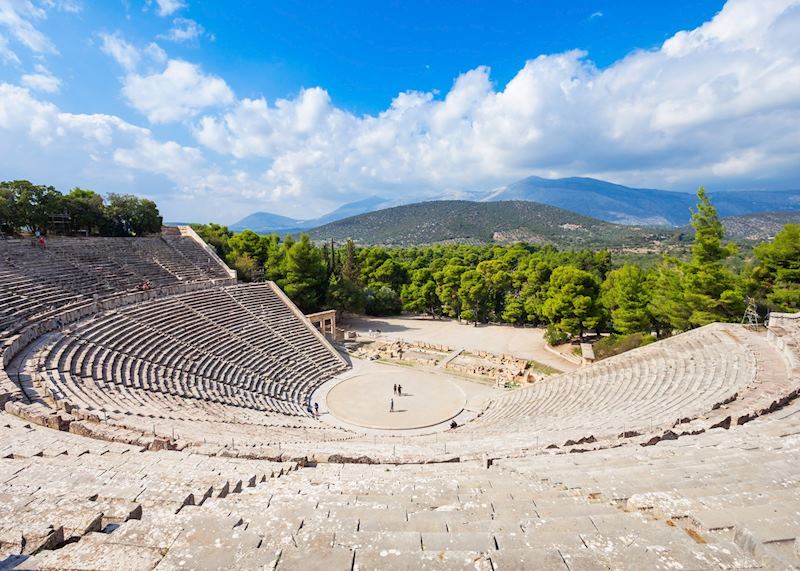
Just a half-hour drive from Nafplio, Epidavros is the home of the Sanctuary of Asclepius, the Greek god of healing. People came from across the Mediterranean and Aegean world to be healed by the doctors and priests who worked here. Prescriptions might include exercise, poetry or drama.
Because of that last requirement, the sanctuary included a massive amphitheatre, which survives almost perfectly intact today. It’s a monument to ancient engineering, demonstrating the perfect acoustics that allow every member of the 15,000 strong audience to hear what’s said.
When I visited, my guide Ilias had me sit in one of the distant seats before he dropped a coin at the middle of the stage. The quiet clank of metal on stone was as loud as if he’d dropped it right by my ear.
It’s no surprise that locals and visitors still take advantage of such an evocative and technically excellent setting. Every summer, the theatre hosts a festival of musical concerts and performances of classic Greek plays. If you can fit it into your schedule, there’s nothing like watching Medea or Oedipus Rex in a 2,400-year-old classical amphitheatre.
I was also fascinated by the rest of the site. Ilias pointed out the dormitories where pilgrims were housed while being treated, the temple dedicated to the god, and the stadium where the ill took their exercise cures.
He also explained that, as a gift to the gods for being healed, supplicants would leave small tokens of their gratitude, often depicting the part of their body that was afflicted. You can see a few in the small adjacent museum, though most have been moved to the National Archaeological Museum in Athens.
Read more about trips to Greece
Start thinking about your experience. These itineraries are simply suggestions for how you could enjoy some of the same experiences as our specialists. They’re just for inspiration, because your trip will be created around your particular tastes.
View All Tours in Greece
